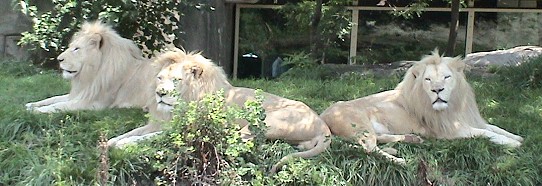
Legend, Wisdom & Courage
|
WHITE LIONS IN CAPTIVITY TODAY |
Mutants are natural variations that occur due to spontaneous genetic changes or the expression of recessive (hidden) genes through inbreeding. Common mutations in big cats are albinism (pure white), chinchilla (white with pale markings), leucism (partial albinism/cream) and melanism (black). White lions, also known as blond lions, are not albino, but are leucistic and are uncommon in the wild as they lack normal camouflage. In the past, the obvious reaction to any unusual big cat was to shoot it for the trophy room. Mutations may have been wiped out before the genes could be passed on. Colour mutations that would disadvantage a wild big cat are now perpetuated in captivity for the sake of curiosity or aesthetics.
I am grateful to Paul McCarthy and others for researching, providing and correcting extensive material, genealogies, historical and current information about white lions. Thanks are also due to Kevin Chambers of the Zoological Animal Reproduction Center for further information on white lions. More detailed information on the history and ecology of white lions may be found in Linda Tucker's book "Mystery of the White Lions - Children of the Sun God
White Lions 1: History and Genetics of White Lions
The White Lion in Mythology and Nature
Accounts of white lions have been around for centuries in Africa, but have often been dismissed as superstition. It has been part of African folklore since prehistoric times and according to legend white lions were children of the Sun God, sent to earth as gifts.
Oral traditions recalls the appearance of white lions over 400 years ago during the reign of Queen Numbi in the region now known as Timbavati. A shining star was seen to fall to the ground, but when Queen Numbi and her people approached, they found it to be a shining ball of metal, brighter than the sun. Queen Numbi, who was an elderly and infirm woman, was swallowed by its light and received by strange beings. When she emerged again, she had been restored to health and youth. The fallen star remained there for some days and then rose back into the sky. Animals with strange deformities were born in that region - cattle with 2 heads, white impala and green-eyed white leopards and lions. To this day, white animals are born in Timbavati, including a blue-eyed albino elephant that was shot by white hunters. Whether or not you believe in visiting spaceships, it is now known that radiation can cause mutations such as those described.
White lions were central to an April Fool's joke in 1860. Late in March of that year, numerous people throughout London received a plausible looking invitation saying "Tower of London - Admit Bearer and Friend to view annual ceremony of Washing the White Lions on Sunday, April 1, 1860. Admittance only at White Gate. It is particularly requested that no gratuities be given to wardens or attendants." By twelve noon on April 1, a large crowd had gathered outside the Tower of London in accordance with the invitation. Lions hadn't been kept in the tower for centuries; the Royal Menagerie having outgrown the tower and become the Royal Zoological Society's "Gardens" in Regent's Park). There were no captive white lions until late in the 20th century. On realising the joke, the disappointed crowd eventually dispersed.
An alternative explanation is that the recessive gene for white/blonde is part of the lion's genetic heritage from the days when lions roamed far more widely. Their habitats included snowy and desert regions where blonde and white colours give better camouflage than tawny and the more successful pale colour morph would come to predominate in such places.
While accounts of white lions have been around for centuries, they were dismissed as superstition. There are now around 300 white lions in captivity and they have been returned to the wild. However, like white tigers, they are an attractive man-perpetuated mutant strain rather than an endangered species in their own right.
At present, all of the white lions in captivity come from the Kruger park subspecies and have not been bred with any other lion subspecies (unlike the comparable situation in white tigers). An exception is the white lion at Toronto zoo which has been bred to a generic male. Unlike normal lion cubs which are born spotted, white lions are born almost pure white. Over the months, their colour gradually darkens to cream or ivory colour.

Legend, Wisdom & Courage
North America
The New York Times index for 1980 states "Stanley Creighton, owner of King Kong Zoo in Tampa, reports birth of three white lion cubs, which may be first of their coloration born in captivity in U.S. (S), Ag 25, 19:1. White lions were exhibited in the USA in 1993 at Philadelphia Zoo. The zoo exhibited two females obtained from Johannesburg Zoo along with two tawny males carrying the white gene.
In October 1993, two Philadelphia cubs were promised on loan to Toronto Zoo as part of a bet. According to several newspapers in October 1993 (this account from the Star Phoenix) "Toronto's zoo has scored some rare white lion cubs after a bet over who'd win the World Series. Lion-mating season doesn't begin until after Christmas but Pete Hoskins, president of the Philadelphia Zoo, was so certain the Philadelphia Phillies would win that he bet his white cubs against the Blue Jays. The Jays clinched the series Saturday. The cubs could be born during spring training next year . . . the white lions and Tasmanian devils [Toronto Zoo's stake in the bet] are part of long-term breeding programs in which zoos lend animals to each other. Offspring are either kept by the zoo of sold to other zoos. Roughly a dozen white lions are believed to exist in the wild, and they all come from South Africa's Timbavati Game Reserve."
Philadelphia Zoo used the white lions to attract the paying public, but at a genetic price to the white lions themselves. Kanya, born in May 1994, was born to a brother-sister mating. The father of the brother and sister is also their grandfather and great-grandfather. Timba, the male in question, had been bred to an unknown female in Johannesburg in the 1970s, then to his daughter and then to his daughter/grand-daughter Bella from that mating. All white lions in captivity can trace ancestry to the Timba-Bella mating, a level of inbreeding not found in the wild where young males are ousted from the pride where they were born.
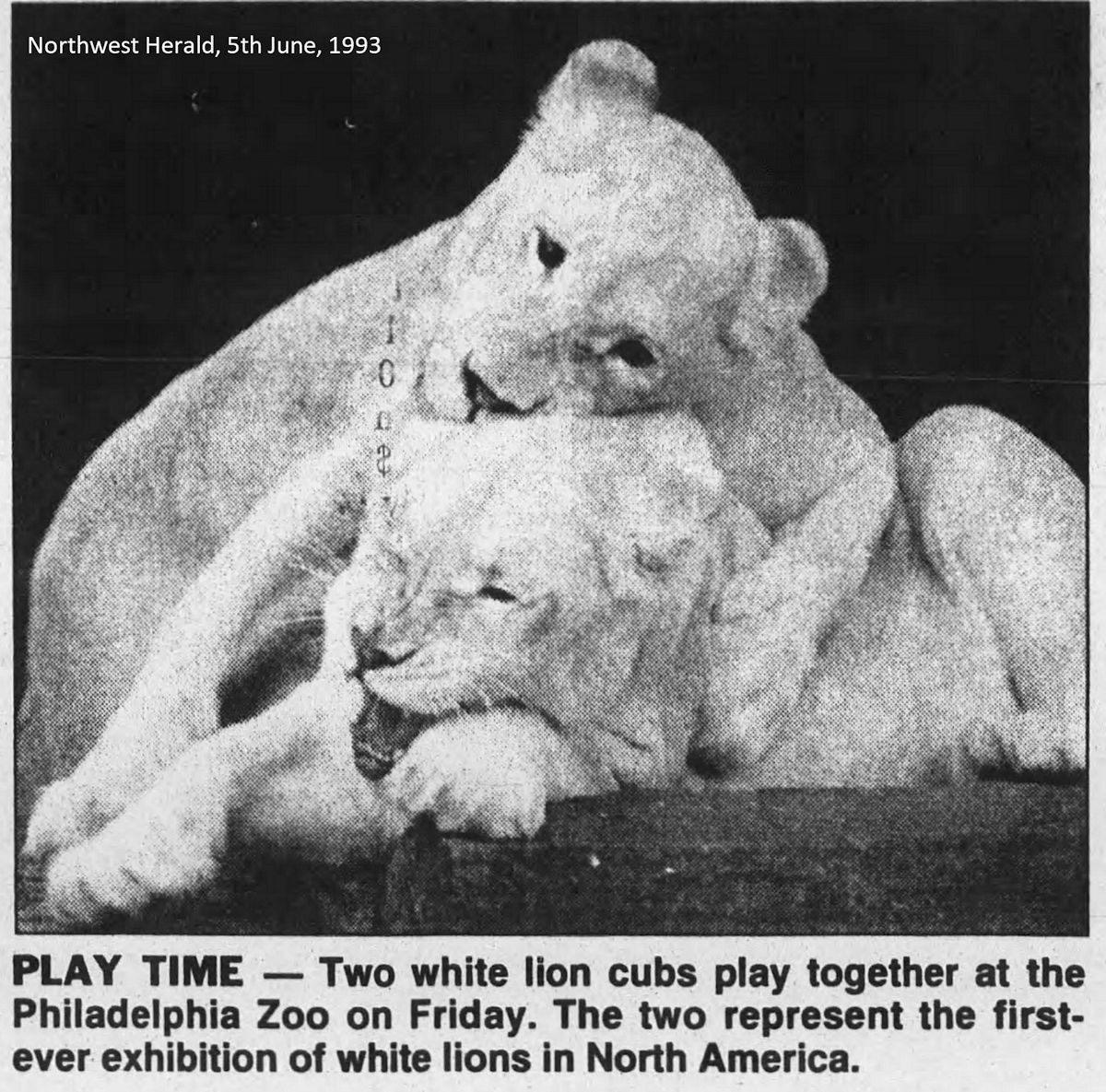
The white lions were not unanimously welcomed. According to the Philadelphia Inquirer, 31st July 1994, after the birth of Kanya, "Although zoo officials were elated with the birth of a second rare white lion cub - another white cub was born in March - they didn't really know whether they had given birth to an embarrassing problem or to the biggest bonanza the Philadelphia Zoo has ever seen. They're banking on the bonanza. Since the zoo acquired its two adult white lions - the only white lions in North America - in the spring of 1993, they are already credited with earning more than $1 million in increased membership. Heaven knows what white cubs may do for the zoo's ailing bottom line. Yet zoo officials well recall the controversy several years ago when the breeding of white tigers got out of hand. Like white lions, white tigers are genetic aberrations produced by inbreeding of the closest kind, between brother and sister and father and daughter, carried out over several generations." To prevent excessive or frequent breeding, the zoo used contraceptive implants in the lionesses.

White Lioness Jezebel at Philadelphia Zoo
In the summer of 1998 white lioness Nakanda became queen of the African Savannah. She was born in Philadelphia in 1996 and loaned to Columbus Zoo, along with her two heterozygous brothers, Tombo ("Clover") and Tonyi ("Charmer"), in 1997. The first offspring of Nakanda was a heterozygous male named Simba, who went to Parc Safari. Philadelphia's white lion pride was loaned to Columbus from August, 2004 to May, 2006, while Philadelphia constructed their new exhibit called Big Cat Falls.
In 1995, white female Sarmoti and tawny carrier male Shaka, from Johannesburg Zoo joined the breeding programme of Las Vegas stage magicians Siegfried and Roy. Like white tigers, white lions are showy animals for use in their stage acts. At that point, there were fewer than 10 white lions recorded worldwide. By September 1996, Siegfried and Roy had 7 white lions. Descendants of their white lions, bred at Fritz Wurm's Safari Park in Stuckenbrock in Germany, are white lionesses, Tandi and Kanya (born to the Philadelphia white lionesses Vinkel and Jezebel), and the Philadelphia heterozygous tawny male Merlin. When Tandi and Kanya went to Germany, Siegfried and Roy acquired a white male called Tran from Japan (South-North Trading, Inc?) as a mate for them; Tran is somewhat darker in colour. Kanya became the mother of Sunshine (male), and Tandi became the mother of Future (male), both acquired by Siegfried and Roy and on permanent loan to Cincinnati Zoo, along with Prosperity (female), a white lioness born in Las Vegas. They went to Cincinnati in 1998 and were exhibited as "The White Lions of Timbavati" along with Millennium. Prosperity had 4 cubs (3 male, 1 female) in 2001. The female, Gracious, remained at Cincinnati while 3 males, Courage, Legend and Wisdom, went to Toledo Zoo on loan in 2003.
According to "The Secret Life of Siegfried and Roy: How the Tiger Kings Tamed Las Vegas" By Jimmy Lavery, Jim Mydlach, Louis Mydlach and Henrietta Tiefenthaler (2008), Siegfried and Roy always claimed that they bought their white lions from Johannesburg Zoological Gardens, but they actually bought many of them from Japan, some coming from a Japanese dealership called South-North Trading, Inc., located in Yuka Saito and specialising in white animals. The lions were bred in barren conditions "barely above the level of jail cells," but this was glossed over by Siegfried and Roy. The book mentions an anonymous rare animal expert who travels to buy exotic animals on behalf of clients and who found that Siegfried and Roy not only bought several white lions from South-North Trading, Inc, but practically monopolized that company's business to prevent competitors from buying white lions. South-North Trading, Inc, operated as a Worldwide Zoo Animal Distributor and its owner had made his fortune operating Japanese racing car circuits. The animals were apparently kept – or warehoused - in a dark and dirty, cement-floored area.
Siegfried & Roy's cubs, supposedly acquired from Johannesburg Zoo, some as young as 3 weeks included: Shaka (male, 1995, tawny carrying white), Sarmoti (female, 1995, white), Pride (born April 1996, white), Joy (born April 1996, white), Freedom (male, born April 2014, white), Madiba (male, born April 2014, white), Timba-Masai (male, born April 2014, white).
The Tallahassee Democrat, 7th February 2010 describes a white lion, Lufuno, at the Ringling Bros. and Barnum & Bailey Circus as part of "Brian McMillan and His Pride of Lions" act. The act comprised six tawny female lions and an extremely rare 450-pound white male lion named Lufuno, meaning "good to love" in Swahili. "Lufuno is like a rock star," McMillan said. "He sleeps 18 to 20 hours a day and works about one hour a day. He has 24-hour maid service and six females. It's not a bad life."
Johannesburg White Lion Bloodline (large image, opens in new window)
White lions from the different strains are now being brought together by the Zoological Animal Reproduction Center which holds 2 white lions (one from each strain) and 5 tawny carriers of the white colour (also from the 2 different strains). These were being bred together to increase the genetic diversity of captive white lions. To produce white individuals requires inbreeding and, if not carefully managed, this also leads to inbreeding depression such as infertility and manelessness in males. A scientific study found 17 of 19 white lion cubs born in an Italian zoo were stillborn or died within a month of birth. Another was euthanised after six months because it could not bite its food and the sole survivor at 30 months was malformed. Some of the deaths may have been poor husbandry (I have no comparable figures for tawny lions from that zoo), but inbreeding can lead to high mortality.
The Wild Animal Sanctuary at Keenesburg, Colorado, has sometimes had white lions rescued from various zoos or other exploitative situations. The rescued animals live out the remainder of their lives in large open-air enclosures.
Toronto Zoo's white lion, Nokanda ("Lucky") (possibly from Philadelphia Zoo), was paired with a lion of mixed blood and produced at least one litter. In 2012, Toronto Zoo received three white lions for their African zone, replacing the single white lioness they had had since 1996. In September 2015, four white lion cubs were born at the zoo.
In the USA, the AZA policy since 2009 regarding big cats means that zoos are no longer allowed to breed generic lions (mixed sub-species lions), including white lions. AZA zoos are forbidden to breed them, or to replace them when they die, or to acquire new ones or even get cubs on loan. Those that are transferred out of an AZA zoo to a non-AZA zoo must be spayed or neutered prior to the transfer. They are permitted to live out their lives in AZA zoos, but many have been spayed or neutered. That leaves only the non-AZA zoos and private owners as possible homes for them, but there are numerous attempts to pass laws, both at the state and federal level, forbidding anyone other than AZA zoos to have big cats, which would leave white lions nowhere to go in the USA. The four-generation Philadelphia dynasty has all but died out by 2018. The three male lions at Toledo have all died, as have the two male lions at Cincinnati. The only two remaining white lions are the two females at Cincinnati, mother and daughter (Prosperity and Gracious), both spayed and both elderly. The mother close to the end of her life, and the daughter will be relocated to another facility. This is unfortunate, because white lions are a naturally occurring colour morph, but those in zoos often originated from circuses or stage acts and are not genetically pure.
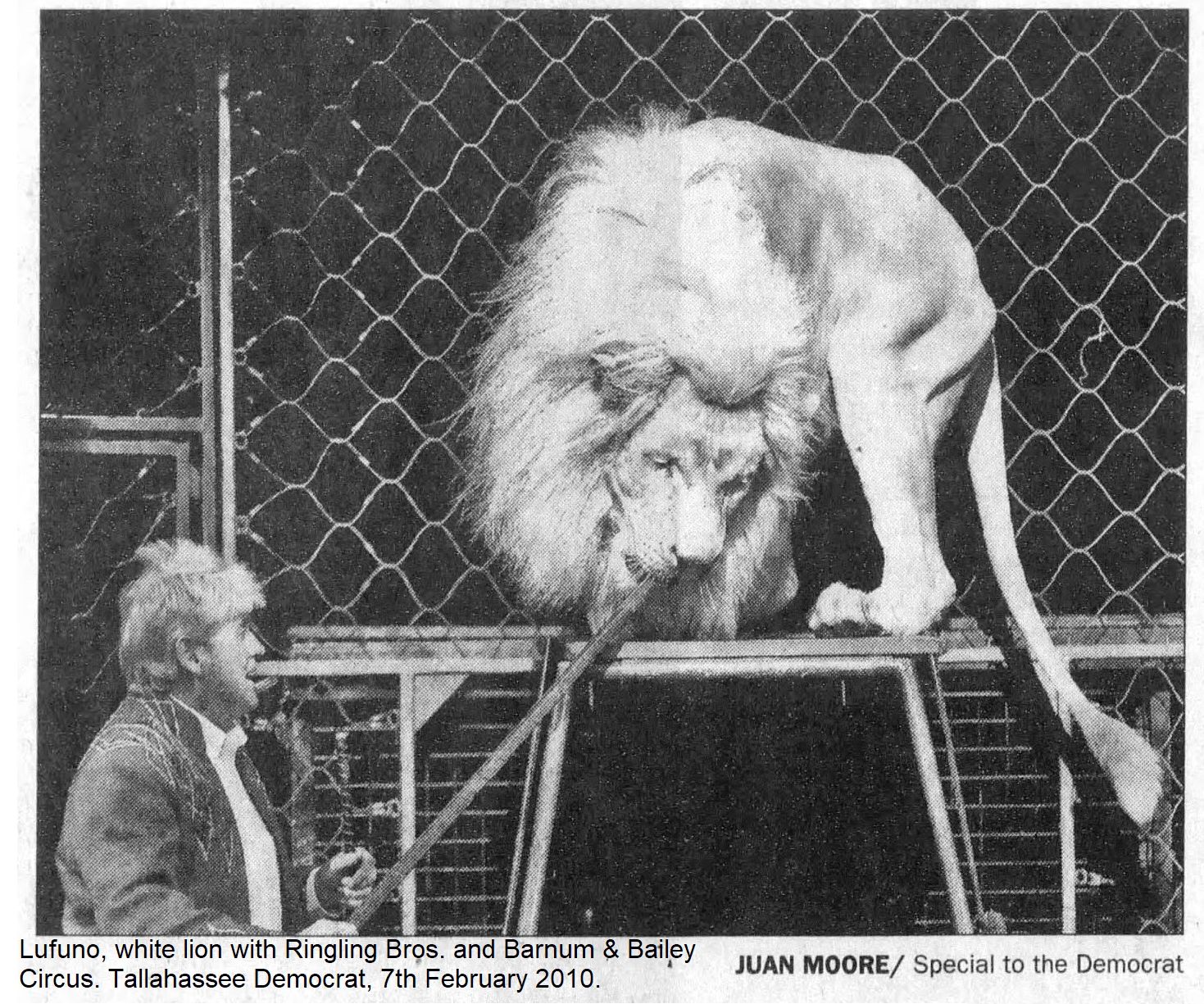
West Midland Safari Park, England
West Midland Safari Park, Bewdley, Worcestershire, introduced the UK's first ever pride of four rare white lions in 2004, at a cost of around £250,000. The group originally consisted of three females and one male, all imported from South Africa, and since their arrival, all three females gave birth to white cubs, with one litter of four cubs and two litters of two. These went on display in 2007 at the "Kingdom of the White Lions" exhibit. The original 4 lions were obtained from Kruger National Park, and were 16-month-old male Mubuto, his sister Natasha, their 15 month old half-sister Johanne and an unrelated 19 month old female, Maryn. Two of the white lions were directly descended from Tombi. A very white male called Casper (born 2006) went to the Isle of Wight zoo. The birthdate means he was Maryn's cub. Two new white lion cubs were born at the west Midland Safari Park in England in 2007.
West Midlands Safari Park & Paraise Wildlife Park Family Tree (large image, opens in new window)
In 2012, six more white cubs, born to two different mothers, took the number of white lions at West Midlands Safari Park to 19, the world's largest captive pride. Two males – Star and Haze – were born to Natasha, while three males and one female - Neptune, Ariel, Oberon and Ophelia – were born to Maryn.
In November 2012, it was found that four white lion cubs born at the West Midlands Safari Park in 2008 had been sent to perform in Japan's Circus Kinoshita after being trained in a British facility. One of the four lions subsequently then went to a zoo in western Japan after being attacked by another animal and developing developed a nervous condition called autonomic ataxia and losing its mane. The Kinoshita Circus website stated that their four performing white lions were born in a UK zoo and trained at a UK site. At 6 months old they were moved to "an animal training facility in the UK . . . they began training there when they were 18 months old." (The males born in 2008 were Neptune, Ariel, Oberon, Star and Haze) The Kinoshita act is billed as "Miraculous White Lions" and their trainer in Mr Michael.
The cubs had been sold to British businessman Jim Clubb of "Amazing Animals" (also known as Heythrop Zoological Gardens) in Chipping Norton, Oxon. Undercover video footage in 2010 appeared to show Clubb training the lion cubs. Months later the same lions were seen performing for a Japanese circus. West Midlands Safari Park was severely criticised for being involved in the trade of big cats to a circus at the same time as promoting itself as based on conservation and welfare.
In 2007 Clubb had appeared on the zoo's own TV channel talking about his company which provides animals to the entertainment industry. It showed the zoo's Head Keeper, Bob Lawrence, delivering two lion cubs to Amazing Animals and discussing their future use in the entertainment industry, though he later said he believed it was for film work. Clubb confirmed that he had received the lion cubs from the West Midlands Safari Park and had provided them, quite legally, to Kinoshita Circus as part of his business. He apparently did not know whether West Midlands Safari Park knew their lions would be going to a circus. The safari park claimed to have sent white lions to Clubb's Heythrop Zoological Gardens in good faith and were unaware of any subsequent moves. (It seems that the name "Heythrop Zoological Gardens" is a respectable front for Clubb's exotic animal trade.)
Paradise Wildlife Park, England
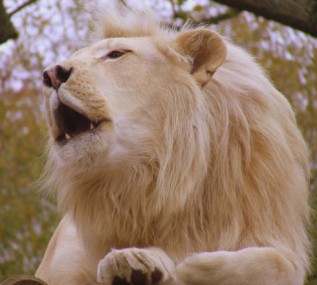
Thabo at Paradise Wildlife Park |
In 2006, Paradise Wildlife Park, Herts, obtained two white lion cubs from Wiets Botes, a South African lion breeder also involved in canned hunting. Paradise Wildlife Park's female, Nala, died in 2007 aged 2-3 years due to skeletal deformities. Vertebrae in her back had nicked her spinal cord and caused paralysis in her hind quarters. Nala had arrived from South Africa in October 2006 with mate, Thabo, and had only been on public display since coming out of quarantine in March 2007. Kya was obtained to replace her. Male Thabo died in 2010 aged 5-6 years from undisclosed causes (he had been unwell and skinny for a while, including when I visited). Paradise's sister park Wildlife Heritage Foundation in Kent specifically imported two more white lion females from Botes in May 2012 to breed with Thabo's son, Themba. Paradise Wildlife Park and the Wildlife Heritage Foundation in Kent produced five white cubs in 2013. (Marita du Plessis, manager of Wiets Safaris, confirmed that Botes could arrange lion hunting but did not use the animals they bred and they only sold the white lions to zoos and not for canned hunting.)
After the death of Thabo, Paradise Wildlife Park obtained male Moto (b. 2007, West Midlands Safari Park) to join white lioness Kya (b. 2007). Kya's daughter Izulu (sired by Thabo) remains with her, but Izulu's brother Themba (b. 2009) went to Wildlife Heritage Foundation to prevent him mating with his mother. Moto and Kya produced Zuri in 2013.
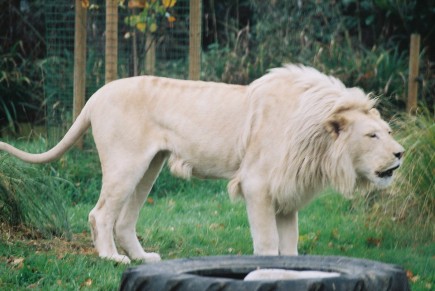
Thabo at Paradise Wildlife Park |
Europe
Britain's first pride of white lions went on display in 2007 at the "Kingdom of the White Lions" exhibit at West Midlands Safari Park in Worcestershire. (See section below.) A second pair of white lions in Britain went to the Paradise Wildlife Park, Broxbourne, Hertfordshire. (See section below.)
Lincolnshire Wildlife Park is one of the UK's largest animal sanctuaries. It has two male white lions named Pascha and Uganda. They arrived in November 2019.
Four white lions - 3 females and 1 male - were born at Jurques Zoo in Normandy, western France in May 2007 to white lioness Nyala. The cubs are being hand-reared as their mother was neglecting them.
Four rare white lion cubs, 10-month-old twin sisters Luna, Ilanga, 7-month-old Credo and 10-month-old Bandhura went to Ouwehands Dierenpark, Rhenen in the Netherlands in December 2010.
There is a white lion at Olmense Zoo in Bukenberg, Belgium.
Magan Zoo, a private zoo in Abony, Hungary acquired two white lion cubs, one male and one female lion.
Pafos Zoo, an Animal and Bird wildlife park in Cyprus, received two seven-month-old white lion cubs in 2011. Athens zoo, in Greece, also has white lions.
Belgrade Zoo in Serbia has 12 white lions. In 2010 four white cubs were produced by two lionesses there. Four white lion cubs were born there in April 2011 to lioness Sumba. She produced another four white cubs on 20th December, 2011. A female white lion cub was born 25th September, 2013, at Belgrade's "Good Hope Garden" Zoo, Serbia, to parents Masha and Wambo. A male was also born but died. This meant that Belgrade zoo had a total of 11 white lions, and that there were around 500 white lions in captivity.
Four white lion cubs were born in the safari-park in Hodenhagen, Lower-Saxony, Germany, in December, 2012.
In December 2013, four white lion cubs were born at Tbilisi Zoo in Georgia and had to be hand-reared. Another three cubs were born in May 2014. In June 2015, a white lion called Sumba was found shot dead on the grounds of the flooded Tblisi Zoo, Georgia (Europe). Many of the animals had escaped from the zoo, or been released from flooded cages to avoid drowning, and some were killed if they could not be safely recaptured, but the director said no animals should have been shot unless they had attacked people or could not be safely recaptured.
White lions named Milady and Rocky were born at Taigan Lion Park, Crimea, Ukraine, in March 2019.
Asia
In 2012, the Karachi Zoo, Pakistan, purchased a juvenile male and juvenile female white lion. These produced 2 cubs. In March 2017, there was an attempt to smuggle white lions from Afghanistan to Pakistan. In April 2017, four of the lions were taken to Kabul Zoo, with the other two lions remaining in Kandahar Province.
The first white lions in Malaysia was in March 2013 at Bukit Gambang Safari Park in Bukit Gambang Resort City (Pahang). There were 2 males and 3 females. Their first white lion cub was born in May 2014 and named King. Two white lions, Zola and Zuri, have resided at the Sunway Lagoon Wildlife Park, Malaysia since April 2015. Taiping Zoo in Malaysia also had white lions.
In June 2013, Thai police arrested a pet shop owner after discovering 14 albino lions smuggled from Africa in a warehouse near Bangkok. Montri Boonprom-on owned a pet shop in Chatuchak market and was previously convicted of wildlife trading. He said the lions had been shipped legally and were to be transferred to a zoo in the north-east of the country but could not explain why there were only 14 lions at his warehouse, when documents showed he had imported 16. The animals were confiscated.
Singapore Night Safari, A subsidiary of Wildlife Reserves Singapore, acquired two white lions, a male and a female.
Taman Safari Bogor, Indonesia acquired seven white lion from Canada in February 2018. A male cub named Link lived in their "Baby Zoo", where visitors can pay to take a photo with baby animals.
Two white lion cubs were born at Bifengxia Zoo, in China, but China is renowned for intensive breeding and numbers will have risen since these were born (when the country ha only 10 white lions).
White lions in Japan are kept by Tohoku Safari Park. There are also white lions performing with Circus Kinoshita; they were born at West Midlands Safari Park.
South America
Three white lion cubs were at Parque Loro Zoo in Puebla on 18th July, 2012. Two of the cubs survived. A white lion cub was born at Leon's Zoo, in Leon, Mexico, on September 14, 2012.
Reino Animal, in Otumba, State of Mexico, has a pair of white lions which can be seen at the "Safari Leones" (Lions' Safari).
South Africa
In addition to Johannesburg Zoo, Pretoria Zoo and the Rhino and Lion Park, there are other white lion breeding programmes (excluding those breeding for canned hunts).
A brown-eyed white lion cub was born at the East London Queen's Park Zoo in South Africa. In Jan 2005, two white and one "brown" lion cub were born there.
There is a white lion breeding programme at Inkwenkwezi Private Game Reserve in South Africa's Eastern Cape province.
Lory Park Zoo, Midrand, South Africa (between Johannesburg and Pretoria) has two adult white lions (Daniel and Heidi), who produced eight cubs. A litter of three cubs in 2012 was hand-reared. A litter of five cubs was born in 2013. three of which were hand-reared and the remaining two (male Gabriel and female Gazelle) were reared by their mother. A male cub was traded Hodonin Zoo in the Czech Republic in return for other animals in August 2013.
In 2018, a 3 year old white lion called Mufasa, was being sold in South Africa after he was taken from an owner illegally keeping him as a pet. An anonymous buyer wanted both Mufasa and a female lion named Soraya, intending to protect both. Over 280,000 signed a petition asking that Mufasa not be auctioned, fearing a buyer might just want the lion for hunting. The lions went to Rustenburg Wildlife Rehabilitation Centre.
Australia and New Zealand
Many thanks to Bec Read for providing much of this information.
Australian Zoos' White Lion Family Tree (large image, opens in new window)
The first white lions in Australia were Magigwana (Great Lion Warrior) and his two female companions, Nkungwe (Mist) and Jubulani (Happiness) who went from Johannesburg to Mogo Zoo, Australia as part of a breeding programme. The long-term aim was supposedly to return their progeny to Timbavati and re-stock the original population there so that white lions would once again occur naturally. A tawny coloured lion from Mogo Zoo's own pride was to have been mated with the white females and the progeny returned to Africa. Taronga Zoo in Sydney, Australia was supposedly going to obtain white lions from Mogo Zoo, but this never happened. There was no plan to breed of white lions for other zoos in Australasia.
In 2004 Mogo Zoo imported white lions Tim, Bella and Snow (originally named Magigwana, Nukungwe and Jubulani). In 2006 Bella gave birth to Purr and Joe, and Snow produced Mafuta and Numbi, who were hand-raised. These remained at Mogo where visitors can hand-feed them as part of the white lion encounter. In 2007, Snow produced 5 males, Djuma, Narky, Timba, Vati and Matimba, who were known as the "brat pack" or "the gangsters" and were transferred to the National Zoo in Canberra, along with half-brother Joe (renamed Megalou). In 2012, Djuma and Matimba went to Mansfield Zoo. In 2016 the other 4 brothers, Narky, Timba, Vati and Megalou, were transferred to Tasmania Zoo.
A fourth litter was born at Mogo on 22nd January 2008. Lika, Apple, Tahba and Makulu were reported to be destined for export to the UK, however all white lions in British zoos originate from South African imports so either the Australian animals were not sent to the UK or they went to a private collection. There is no further information on these 4 white cubs beyond a birth announcement and photos of them aged around 6 weeks.
Tim and Bella from the original Mogo import were transferred to Altina Wildlife Park, NSW, in 2012. In 2014 they produced Holden, Kimba, Elsa and Neferity, who remained at Altina. In June 2017, males Holden and Kimba were exhibited at Dreamworld, Queensland for 2 weeks. Tim and Bella both died in 2018 and Tim became a taxidermy specimen on display in Altina's museum.
Snow remained at Mogo Zoo and on 9th August 2012, Snow she had a third litter with tawny male Mac. These cubs were tawny but carried the white gene. In 2014, Snow had a fourth litter, comprising 2 tawny females Zuri and Chitwa, also sired by Mac. A press release for the 5 males born in 2007 had said they would be Snow's last litter, but she was bred twice with tawny male, Mac before receiving a contraceptive implant.
Snow's daughter Chitwa had a tawny male cub, Phoenix, on 23 December 2019, sired by tawny male Baako. Chitwa's sister, Zuri was also breed to Baako. She died due to birthing complications in December 2020. Although two of her four cubs were born alive, only one tawny female cub, Maji, survived. Her third cub was stillborn and the fourth (already dead) caused severe internal injuries as she tried to give birth to it. The sire of these litters, Baako, was the son of South African imports Lazarus and Maya. His pride comprised Snow, Chitwa and Phoenix. Maji was hand-raised and not part of the pride.
In November 2019, Mogo Zoo went from being a family run zoo, to one small part of Sydney's Featherdale Wildlife Park which does not provide information to the public (assuming the records still exist.)
In 2009 Zoodoo and Darling Downs Zoo both imported a pair of white lions from South Africa. Shaka (M) and Shenzi (F) went to Darling Downs Zoo. Bakari (M) and Kiara (F) went to Zoodoo. A white male named Kwanza ("First") was born to Shaka and Shenzi at the Darling Downs Zoo in Queensland on 12th November, 2012. He was the first white lion cub to be born at a Queensland zoo and survived an attack from a lioness while being integrated with 3 other cubs in 2013. On 13th January 2015, 3 cubs (1 male, 2 females) were born at Darling Downs Zoo and nicknamed Lazy Boy, Mummy's Girl and The Terror. A male and female went to Hunter Valley Zoo in 2016 and were renamed Kovu and Nala. The remaining female, renamed Msichana, stayed at Darling Downs.
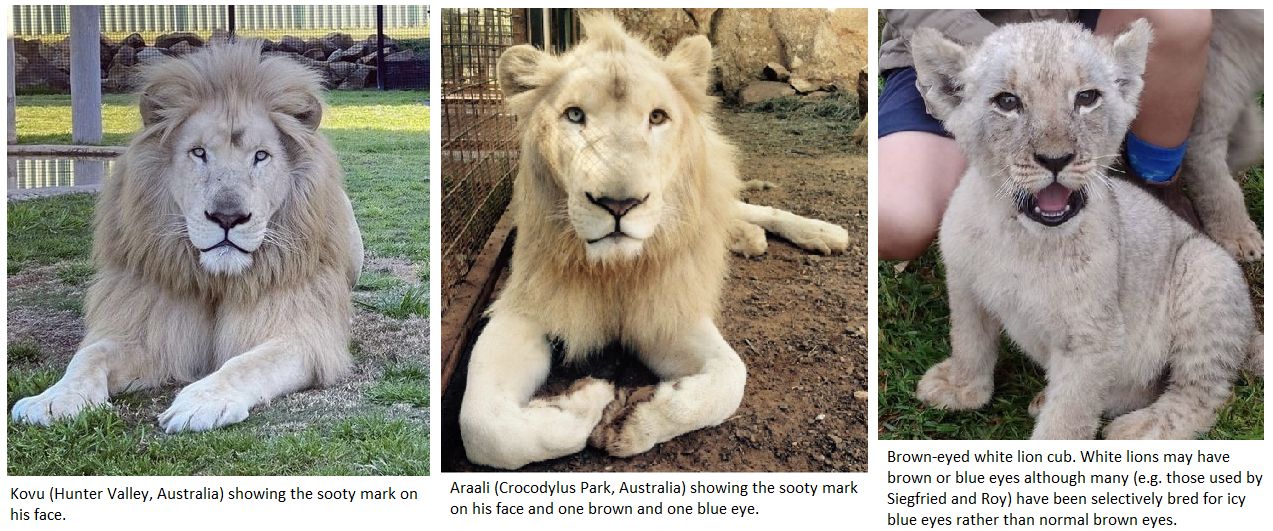
The first litter to Bakari and Kiara at Zoodoo was born in 2013. The 2 males, Zuri and Araali, were transferred to Crocodylus Park in 2014. Araali has heterochromia iridum: one blue eye and one green eye. On 13th January 2014 Bakari and Kiara produced a second litter comprising 2 males and 2 females: Jabari, Kibwana, Gimbya and Jaja. The four offspring went to Shoalhaven Zoo in 2016.
Also in 2009, the National Zoo imported a brother sister pair of white lions, Jake and Mischka, from Tygerberg Zoopark in South Africa. These were exhibited at Dreamworld in April 2011 while their enclosure at Canberra was renovated. The National Zoo has not bred any white lions.
By 2021, nine white lion litters had been bred in Australia. 4 at Mogo Zoo, 2 at Darling Downs Zoo, 2 at Zoodoo and 1 at Altina Zoo, plus Snow's 2 tawny litters carrying the white gene at Mogo Zoo. The last white lions born in Australia were the those at Darling Downs Zoo in 2015. Darling Downs Zoo plan to breed their white female (born 2015) with a tawny male. Snow's tawny line at Mogo will also continue to be bred from although none of the white lions or their progeny are able to be registered with the ZAA due to the policies on breeding from colour mutants.
There was a white lion breeding progamme at the privately owned Kingdom of Zion Wildlife Gardens, Whangarei, New Zealand (which became Kamo Wildlife Sanctuary in 2014) which acquired a white male cub named Gandor in 2004 (along with tawny female Shakira) from the Rhino and Lion Nature Reserve near Johannesburg. Gandor and Shakira produced three cubs in 2006(?) Tshaka (M), Abdullah (M) and Cleo (M), all tawny carrying the white gene. In 2004, Kingdom of Zion obtained 2 white females Amafu and Imvula and male Laduma from the Rhino and Lion Nature Reserve at Krugersdorp, South Africa. There was criticism of this park over the routine declawing of the big cats, a type of mutilation that leads to painful feet.
Gandor supposedly came from tawny parents at the Rhino and Lion Nature Reserve, though there has been speculation that he resulted from a mating of Thandile, the white female cub discovered at the park in 1999.
In some Australian white lions there is a sooty mark on the faces. This is very apparent in Kovu at Hunter Valley and Araali at Crocodylus Park (they may be related as their parents were imported at the same time).
Because the condition is not albinism, white lions may have normal brown eyes, although there seems to have been selective breeding for blue eyes (which can occur with the chinchilla gene). This is a brown-eyed white cub at a game reserve in South Africa. It has very prominent markings at this age.

Canned Hunting of White Lions
While most people are content to see and photograph white lions in zoos or, if lucky, in the wild, some of the sicker examples of the human race pay around $200,000 to shoot a captive white lion. South African author Linda Tucker details canned hunting in her book "Mystery of the White Lions - Children of the Sun God". The canned hunt industry is controlled by tight syndicates that exclude outsiders from facilities where lions are bred to be killed. Footage of lions bred for canned hunts at Timbavati show them to have defects due to inbreeding and confinement: bone defects, missing tail tufts, hinquarter paralysis and, in one individual, an open wound on the forehead that resembled a bullet hole. According to Tucker, some cubs bred for canned hunts have required open heart surgery at Onderstepoort Veterinary Hospital, indicating a damaging level of inbreeding. Those cubs got treated just so they could survive to adulthood and be shot. The hunters are mainly foreign tourists who want a white lion trophy. The lion is penned in a small enclosure and the trophy-hunter shoots it from behind the fence. Being used to humans, the lions may go to the fence to investigate their visitors. Many of the hunters have no experience of killing and shoot the captive lion several times before it dies.
Textual content is licensed under the GFDL.
For more information on the genetics of colour and pattern:
Robinson's Genetics for Cat Breeders & Veterinarians 4th Ed (the current version)
Genetics for Cat Breeders, 3rd Ed by Roy Robinson (earlier version showing some of the historical misunderstandings)
Cat Genetics by A C Jude (1950s cat genetics text; demonstrates the early confusion that chinchilla was a form of albinism)
For more information on genetics, inheritance and gene pools see:
The Pros and Cons of Inbreeding
The Pros and Cons of Cloning
|
BACK TO HYBRID & MUTANT BIG CATS INDEX |